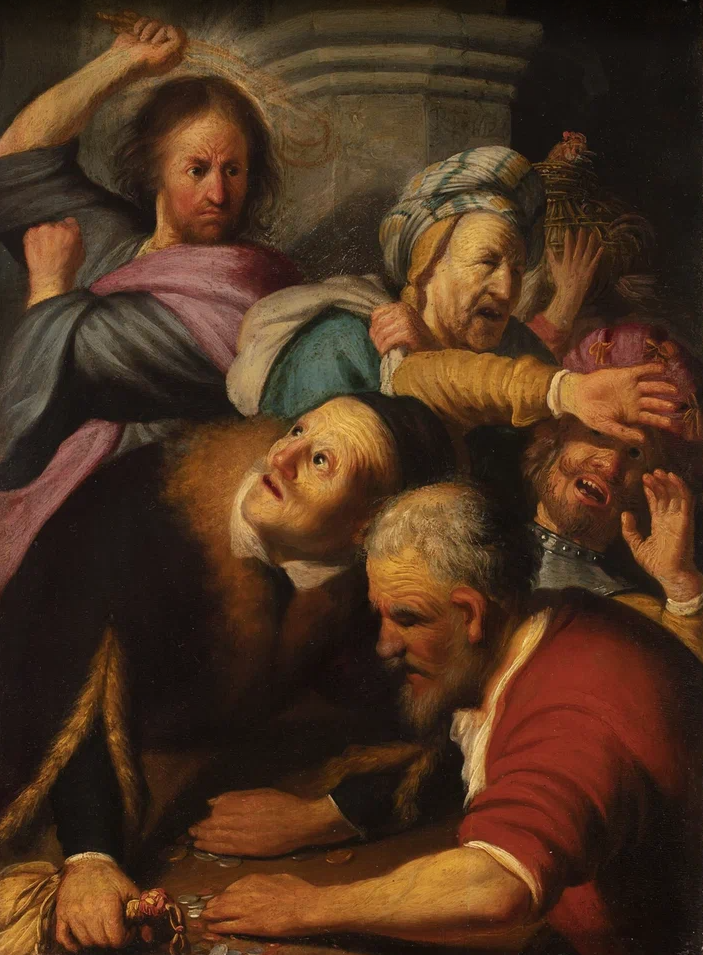Rembrandt Harmensz. van Rijn. Christ Driving the Moneylenders from the Temple. 1626.

Rembrandt van Rijn's painting Christ Driving the Moneylenders from the Temple is based on a biblical episode. The events take place during one of the most important Jewish holidays, commemorating their liberation from Egyptian slavery, and touch upon two legal themes. The first concerns the expulsion of merchants from the Jewish Temple.
It is known that Jewish law, being one of the oldest legal systems, is inherently religious in nature and draws upon numerous sources, including sacred texts and their commentaries.
During Passover, thousands of pilgrims would gather in Jerusalem. According to Jewish law, pilgrimage to the Temple required sacrificial animals, which pilgrims could purchase from merchants in the Temple complex. On one hand, this trade provided pilgrims with necessary offerings, but on the other, it violated the strict prohibition against any work on the holiday and within the Temple grounds. This is what provoked Jesus' anger. He fashioned a whip from cords and drove out both the sacrificial animals and the merchants.
The second legal issue concerns the overturning of the money changers' tables. Within the Jewish Temple and its precincts, the use of Roman and Greek coins was prohibited, as they bore images of humans, animals, and pagan deities. Roman coins featured Caesar's portrait, while Tyrian shekels displayed the city god Melqart depicted as Heracles, along with the Ptolemaic eagle - a symbol associated with Zeus. Consequently, pilgrims needed to exchange their currency for Temple shekels to purchase sacrificial animals. This was the business of the money changers depicted by Rembrandt.
According to biblical accounts, the Temple guards did not intervene—they neither attempted to stop Jesus Christ nor defended the merchants. Modern scholars suggest their inaction may have stemmed from a desire to avoid provoking unrest, as many pilgrims supported Jesus' actions. It is also believed that Christ was protesting against sacrificial practices that created among believers an illusion of transactional bargaining with God at the expense of genuine repentance. This position was shared by other prophets contemporary to Jesus, such as Jeremiah and John the Baptist.
Among the objects carrying legal and symbolic significance in this episode, the money changers' table stands out. In biblical tradition, a table transcends mere furniture—it symbolizes communion, divine hospitality, and God's benevolence, representing grace and kindness. The New Testament frequently depicts Jesus sharing meals with people from all social strata, demonstrating that God's love and grace are accessible regardless of social standing.
Though not visible in the painting, Roman denarii hold great significance in this context. At the time, Palestine was a province of the Roman Empire, with a Roman garrison stationed in Jerusalem. All Jews were required to pay a tribute to the Roman emperor—a tax collected by publicans, who were despised by Jewish patriots as collaborators. Roman fiscal and monetary policies contributed to the widespread circulation of Roman coinage throughout the region. Roman tax and monetary policies led to the spread of Roman coins in the region.
A distinctive feature of Rembrandt's paintings is his masterful use of chiaroscuro, creating dramatic contrasts between figures through the interplay of light and shadow. The artist applied paint thickly and texturally to illuminated areas, sometimes using a palette knife or even his fingers rather than a brush. While many later adopted this technique, none employed it as consistently or inventively as Rembrandt.
In the painting, the artist left his monogram "RHL" visible on a column behind the merchants—his characteristic signature. The initials stand for: "R" (Rembrandt), "H" (Harmens, his father's name), and "L" (Leiden, his hometown)/